Magnolia tree planting and care. Magnolia: planting, care.
Magnolia is a surprisingly beautiful plant, still a rare guest in our gardens. And blooming magnolia few people have ever seen. If you are lucky - they will certainly want to plant her at home.
Magnolia Description
Many amateur gardeners mistakenly believe that magnolia is a plant in the southern regions. Meanwhile, individual specimens today can be found even in the suburbs and the Leningrad region, where the climate is much more severe.
The most winter-hardy that can successfully grow in the middle lane: Magnolia Cobus, Magnolia star, Magnolia Siebold and Magnolia Lebner.
Magnolia Care
Magnolia develops well on loose fertile soil with a slightly acidic or neutral reaction. She does not tolerate excess lime. He loves the sun, therefore, in a shaded place it blooms poorly or does not bloom at all.
In dry weather, watering is required. For magnolia, it is advisable to choose a place protected from cold winds. Resistance to frost the plant gains only in the third year of life. The frost resistance of the same species is highly dependent on the frost resistance of the mother plant.
Plants grown from the seeds of magnolia in the southern regions are much less hardy than those obtained from seeds of trees growing in harsh conditions. Recently, seedlings grown in Western Europe, where winters are much milder, have appeared on sale.
It is difficult to judge how such plants will behave in our conditions. It is still advisable to purchase seedlings grown in similar climatic conditions.
Most types of magnolia are well propagated by seeds and green cuttings. It takes three years to grow a good seedling.
My acquaintance with magnolia took place several years ago, when I read a rather extensive article about it in one of the magazines. And in the same year in the old abandoned garden of a passionate collector, I found two magnificent copies of the magnolia Kobus.
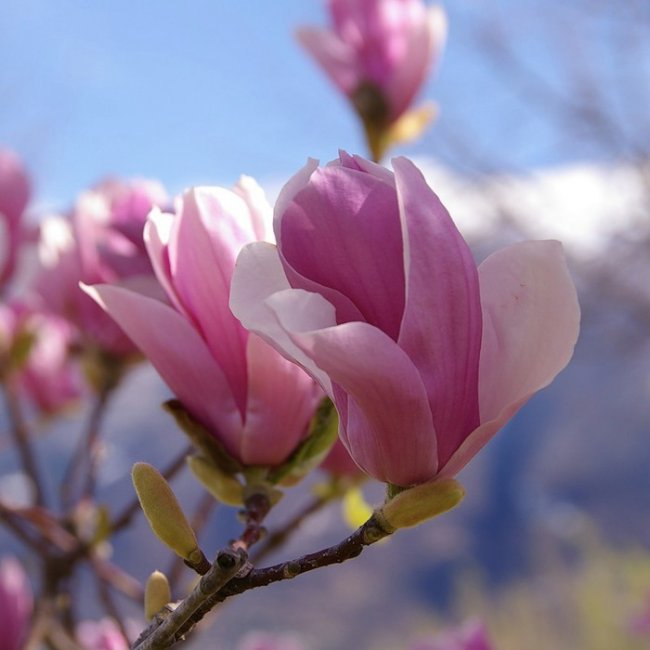
Low trees at the age of 15-20 amazed with their beauty. Beautiful leaves, branches, a magnificent crown shape - such a tree will decorate any garden. Early spring, the trees are still bare, buds are just beginning to swell, and it is already in bloom.
Large milky white flowers on bare branches seem unrealistic. Blooms magnolia Kobus about two weeks.
I tried to grow from seeds - it turned out. I did not dare to leave young seedlings to winter in the open ground, I kept the first year in the basement. On the street I left only a few pieces to test them for winter hardiness.

Both of them wintered well. In the spring they started to grow together and grew 25-30 cm over the summer. They prepared well for wintering: the wood ripened, the leaves turned yellow and almost fell.
For the winter, she again cleaned several copies in the basement, leaving a part in the open ground to make sure of their winter hardiness. Although, apparently, this is unnecessary, the winter hardiness of young plants should be high, due to good heredity: the fallopian trees suffered more than one severe winter.
In some years, frosts reached 30-33 degrees, but I did not find frozen branches on any tree.
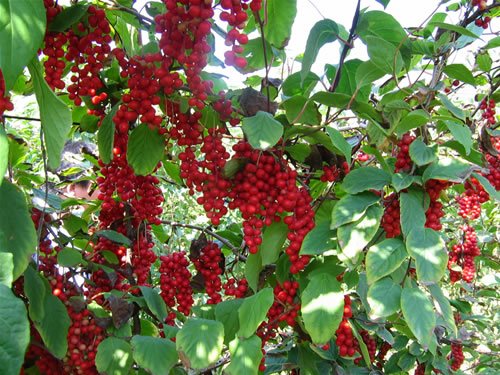
In large gardens, it is advisable to grow magnolia in the form of a tree, and in small areas by pruning it can be formed in the form of a large bush. Both forms are good and effective in their own way.
I hope that in the near future the magnolia will have a much larger number of fans, and it will decorate many gardens with its magical beauty.
Magnolia is a very beautiful plant. Her leaves are simple, and the flowers are large, have a white, cream, yellow, pink, purple color. Her buds exude a pleasant and very delicate aroma. Magnolia has decorative fruits that become a real decoration of a tree from the end of summer until the end of the autumn period.
Magnolia is used in landscape design. It looks great against the background of conifers. In order for healthy and beautiful magnolias to grow in your garden, you need to plant them correctly. How to plant magnolias correctly, we will consider in this article.
Types of Magnolias:
- Virginia Magnolia - grows well on acidic soils.
- Magnolias of Sulange, Siebold - less resistant to frost, plant these magnolias in the corners protected from the wind and direct sunlight.
- Magnolia Cobus, Star, Lebner can grow in open sunny areas.
- Magnolias Reverse Ovoid, Triohpelyustkov tall trees with large leaves, grow well in trees with a deep root system (pine, oak, birch). However, for laying flower buds and abundant flowering, they need the necessary lighting at least in the afternoon.
Where to plant magnolia
Choose a place for magnolia protected from the wind, especially from cold winter winds, Mon.-Zap. direction. Magnolias do not really like open sunny places. They prefer diffused light or light partial shade. Magnolias grow well on well-drained, moist (not tolerate stagnant water, loose, rich in organic substances, acidic (Ph 5.5-6.5) soils.
Note. One of the reasons for the poor growth of magnolias is the presence of lime in the soil. Avoid places with stagnant moisture, carbonate and saline soils. When choosing a place for this plant, you need to consider the growth of a tree or bush in adulthood.
How to plant magnolia
Young seedlings of magnolia need to be planted immediately in a permanent place, magnolia does not tolerate transplants. Magnolia is not very whimsical to the soil, but it will be better to grow it in weakly saturated organic soil. For planting seedlings, you can prepare a mixture of the following components: turf land, peat, compost (2: 1: 1). The soil for planting the plant should be loose, moderately moist. If the soil is too dense, it must be mixed with sand, vermiculite or perlite.
The pit for planting magnolia should be 3 times larger than its root system. After we planted, the soil around it needs to be heavily tamped and watered. The trunk circle must be covered with bark of coniferous trees (mulch) so that the moisture evaporates more slowly.
Important. Make sure that the roots of the plant do not dry out before planting. To prevent this from happening, it is best to buy seedlings in a container. Thus, magnolia will easily transfer the planting to the open ground.
When to plant magnolia
Magnolia, which was bought in a pot, can be planted in open ground throughout the entire warm period, but it is better to do this in the fall (no later than October). It is at this time of year that she is at rest. A seedling is best to choose one that has flower buds.
If you plant a magnolia tree in the spring, then the plant begins to actively grow, the seedling will give a good growth and often switches to wintering already with shoots that did not have time to rustle. In this case, those shoots will freeze in the winter.
Magnolia Care
Magnolia is an unpretentious plant, it is easy to care for it.
How to water magnolia
You need to water the magnolia regularly, in the first year after planting. If there is a dry summer, the tree should be abundantly watered (not too cold water), but it is impossible to overmoisten the soil!
Mulching and weeding magnolia
Within a radius of 40 cm from the plant, the soil surface must be mulched so that moisture evaporation is minimal. Magnolia has a superficial root system, so cultivating the soil around the plant is not recommended, so as not to damage the delicate roots of magnolia.
Fertilizer for magnolia
After flowering, during the development of leaves and fruits, magnolia needs to be fed with complex mineral fertilizers - this will help to develop better, will be more resistant to weather conditions. The last feeding should be done no later than July, because at the end of August the magnolia goes into a state of rest and begins to prepare for wintering.
Shelter for the winter At 1, 2, 3 years after planting in open ground, the lower part of the trunk and root system should be covered for the winter (in November), with special agro-fabric, coniferous branches, straw, the mulch layer should be 20 - 30 cm .
Pruning magnolia
In global pruning magnolia does not need. Trim dry, damaged branches. Frozen flower buds, cut off after flowering. You should also cut off those branches that grow in the middle of the crown. This procedure helps to improve the decorative appearance of magnolia, as well as active growth and development. Treat all sections with garden var. 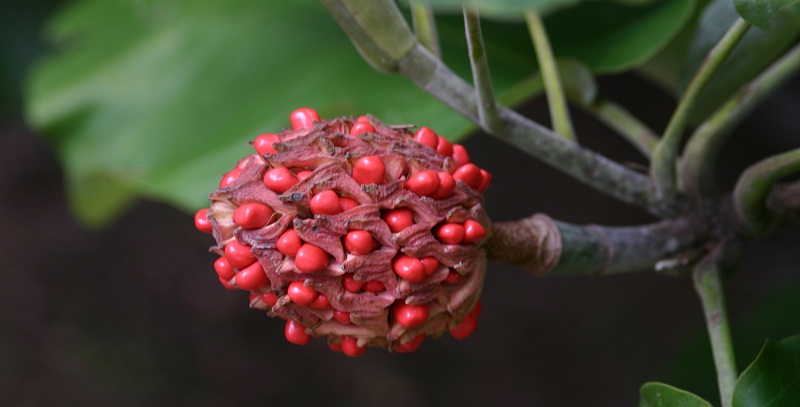
Magnolia propagation
Magnolia is propagated by seeds, cuttings, grafting.
Pests and diseases
Magnolia is practically not sick and is not damaged by pests. But, if you notice yellow leaves - insufficient iron content in the soil.
Magnolia flowers is a holiday of spring and beauty.
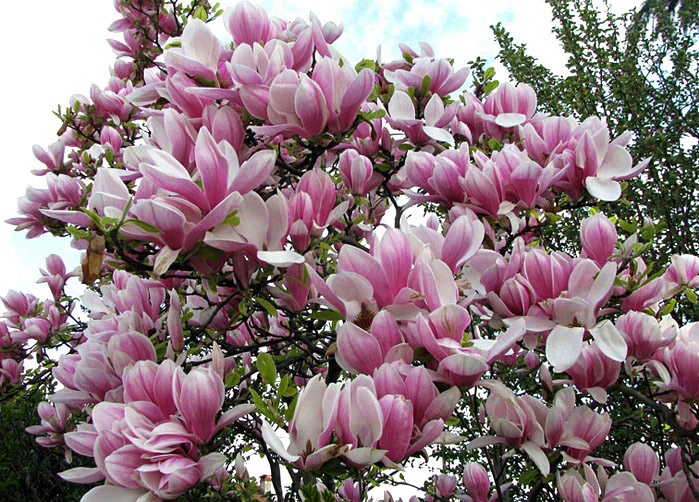
Magnolias are blooming, the smell is sweet
Amidst hundreds of smells of enchanting spring.
In the shadow of fluffy crowns I stand and furtively
I heed tremblingly to the wealth of silence.
In it, every sound is so clear, pure and sweet,
Like music, like a favorite song of singers.
And bird voices weave their ballads ...
I understand the meaning without understanding the words.
I am surrounded by the warmth and whiteness of flowers
Their delicate smell, cherished in the spring.
And laughing merrily, the spirit of the gardens spins
In the azure radiant skies above me
And the sun pours rays on the reborn temple
Where life boils with pitch and wishes again.
All that I have, without thinking, I will give,
Just to stay here among the flowers of magnolias. ![]()
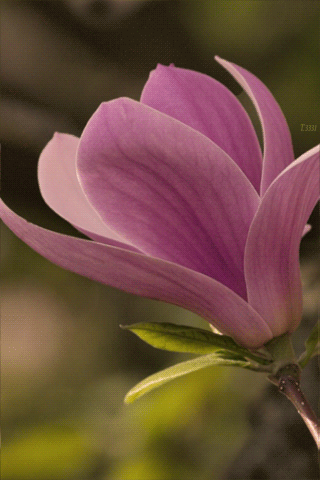
Magnificent Magnolia Flower! Spring and magnolia are one, because in early spring, when there is still no foliage on the trees, magnolia impresses the eye and mind with the beauty of buds and flowers,
adorns parks, gardens and city streets with its wonderful colors.
Imagine branches with almost no leaves, but covered with large, wonderful flowers 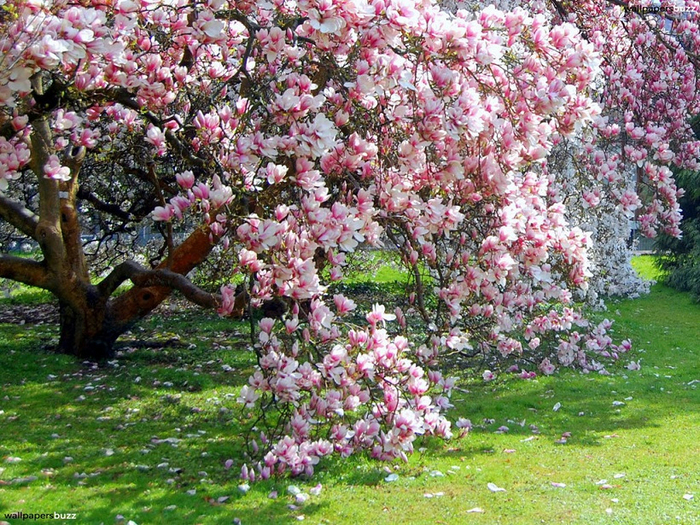
The parks are fabulous, the aromas of spring and flowers give pleasure and relaxation.
It’s impossible to go past such beauty so as not to photograph the birth and how the buds and flowers open, and then the wonderful flowering.
The beginning of the flowering of magnolia is an amazing time. 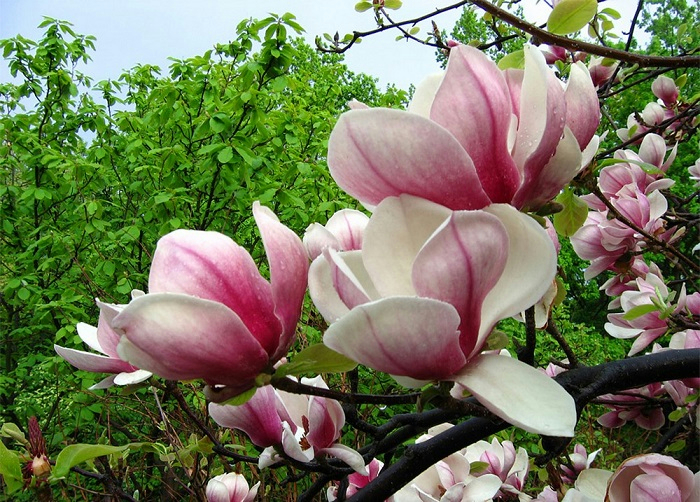
The beginning of the miracle of flowering is the magnolia bud.
A little more and the magnolia flower will bloom!
Magnolia bud to meet new life. ![]()
Magnolia is considered one of the oldest inhabitants of the kingdom of Flora, its beautiful flowers bloomed in the time of the dinosaurs. Nowadays, the flower has not lost popularity. Seeing magnolia once and breathing in its heady aroma, you are unlikely to forget it. 
The plant is an evergreen tree with fleshy glossy leaves and large flowers, which come in different colors - from white to dark pink. Magnolia comes from Asia and North America, but feels good in any southern countries. The powerful of this world adorned their residences with magnolia, so magnolia is considered the flower of kings. 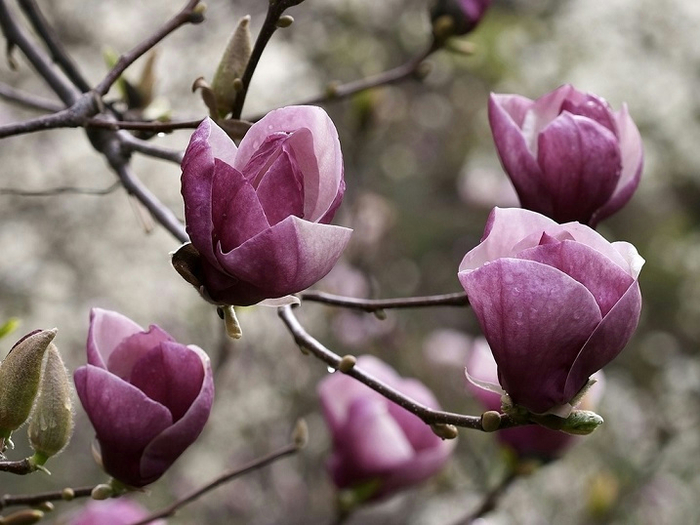
In China and Japan, many legends are associated with a beautiful flower. Magnolia there is considered a symbol of femininity, innocence and beauty.
According to ancient Chinese tradition, magnolia flowers are girls from the same village, which was destroyed by invaders. When the last girl survived, she asked the earth so that the young bodies of her and her friends would not see decay and not get the invaders. And in the morning the bodies really weren’t in the execution square. But in the midst of her was a tree with beautiful buds. The invaders chopped wood into pieces and scattered across the steppes. But where a piece of wood fell, a new one grew in that place, and buds of resurrected girlish souls bloomed on it. According to legend, this tree is magnolia.
The spectacle is really fabulous, as if you are on another planet, where there are huge buds on a tree, you can’t even believe that these are real flowers and not a single leaf. 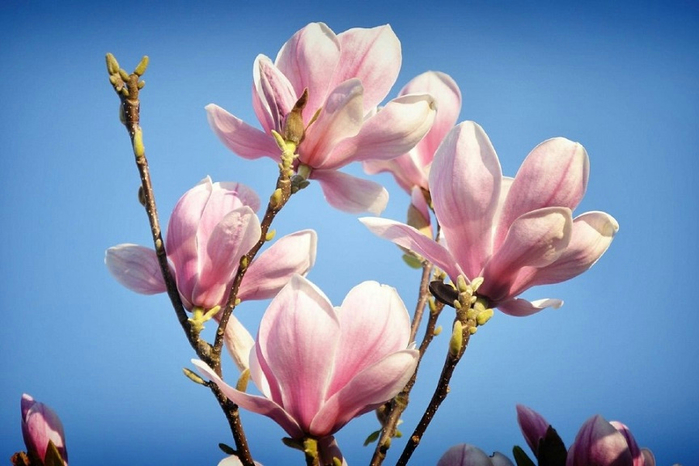
Delicate magnolia flowers conquer with its originality and harmony. The magnolia plant belongs to the oldest magnolia family, consisting of more than 70 species.
Magnolia is an evergreen tree with beautiful large flowers, which come in different colors - from white to dark pink. 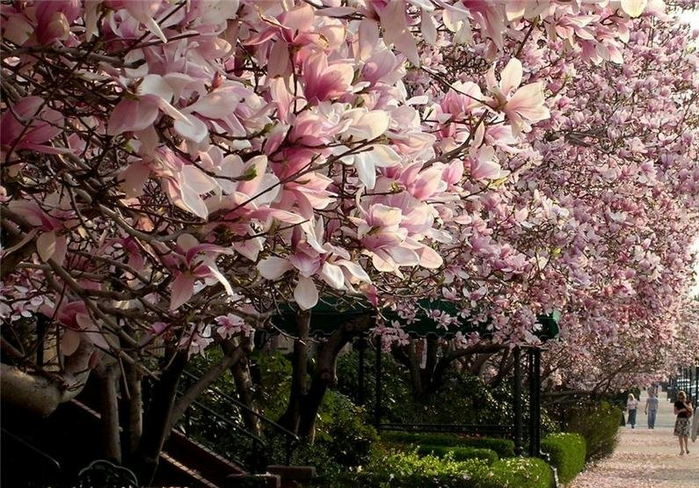
This is one of the most beautiful and magnificent trees, having a dense wide pyramidal crown, reaching a height of 15 meters.
The leaves are large, simple oval, leathery; the upper side is dark green, bare, shiny, the bottom is covered with rusty pubescence. Each leaf does not live long, as the young leaves grow, the old ones fall off. Fragrant flowers are very spectacular - large, cupped, located singly at the ends of the branches. Magnolia blooms in spring and summer, forming a fruit resembling a conifer cone. 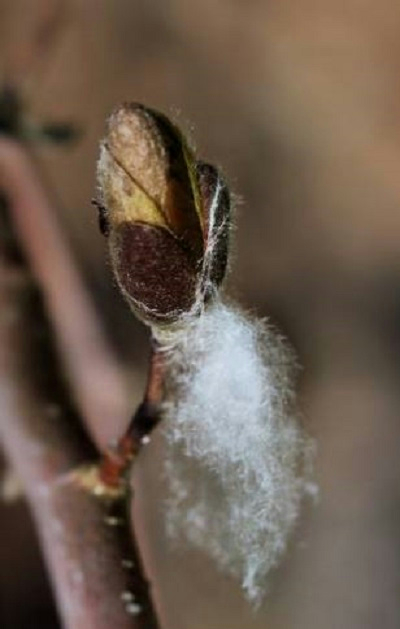
The magnolia bud is as fluffy and furry as a willow, only larger 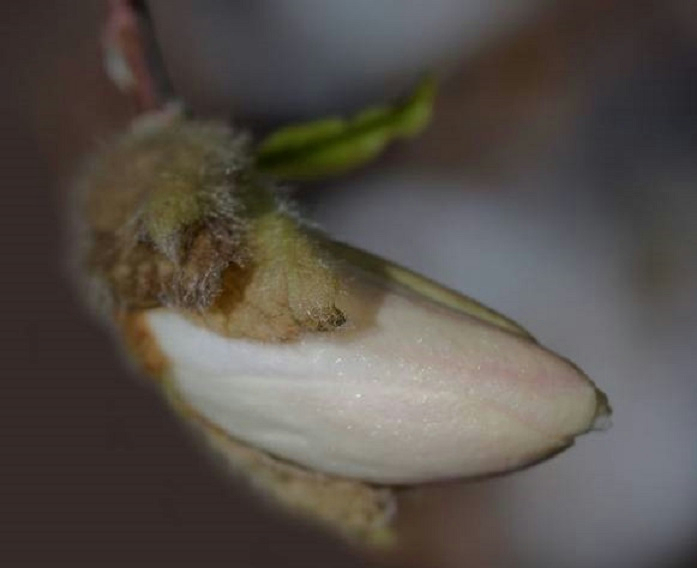
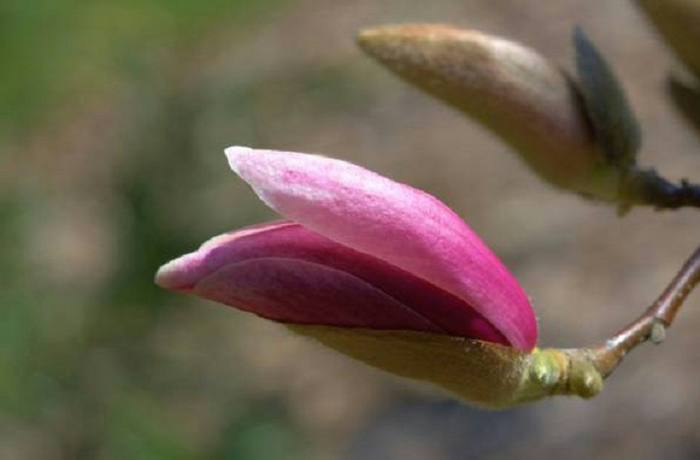
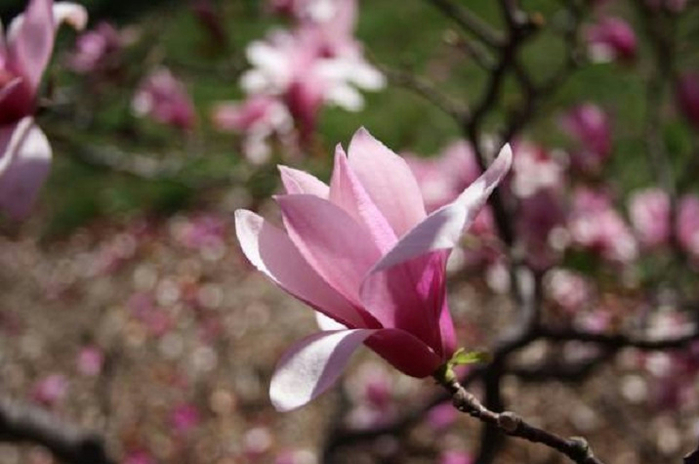

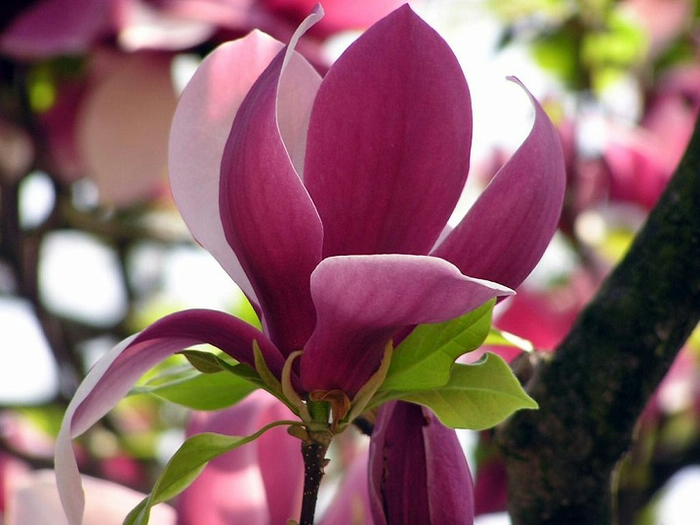
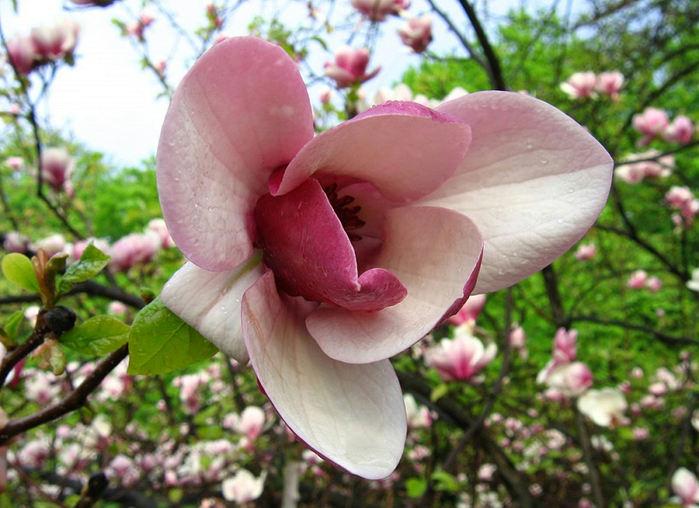
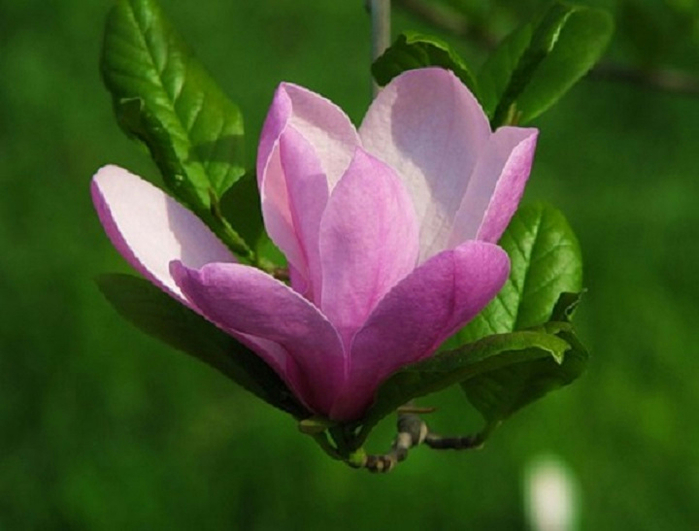
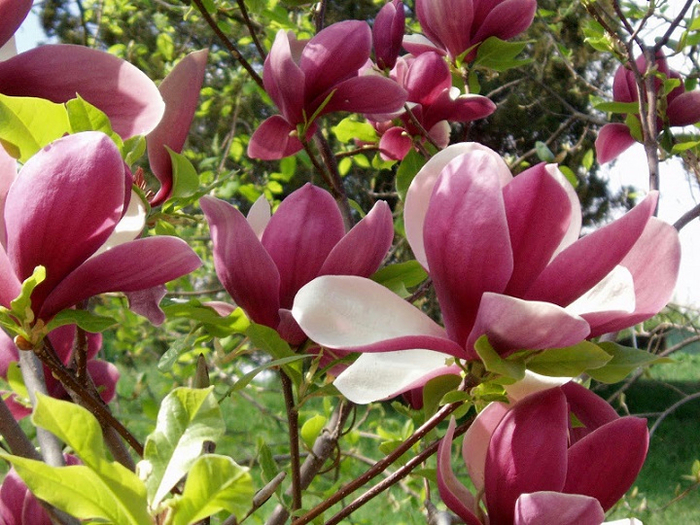
Spring day. Magnolia flowers tremble in the sun, as if welcoming and endowing with beauty the world and guests of the park, where the trees are so cozy and free to grow. 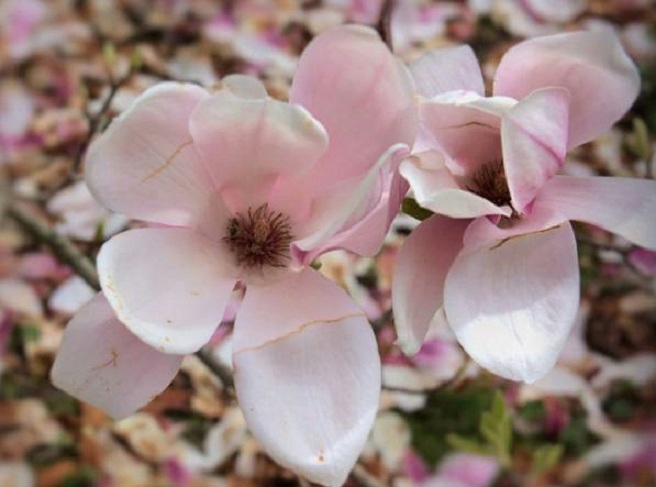
In the sun, pink magnolia is especially beautiful. See how magnificent the magnolia flower 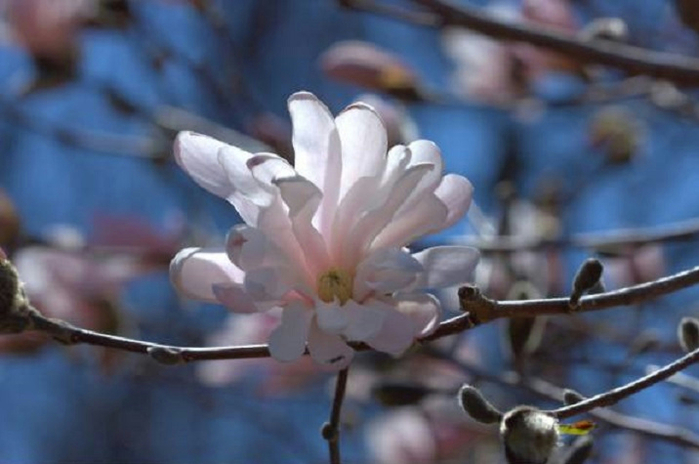
This magnolia blooms one of the last, until mid-summer.
Her flowers are dense, large in shape and fragrant, nourished by saturated green foliage, very expressive. And at the same time they are very similar to ficus leaves in hardness.
The flowers of this type of magnolia are snow-white. 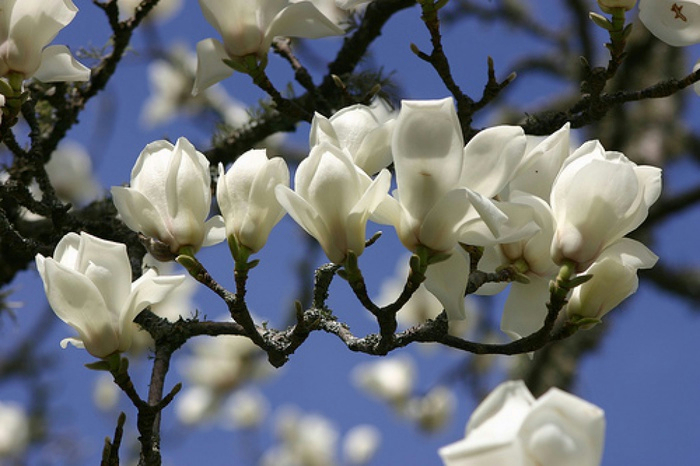
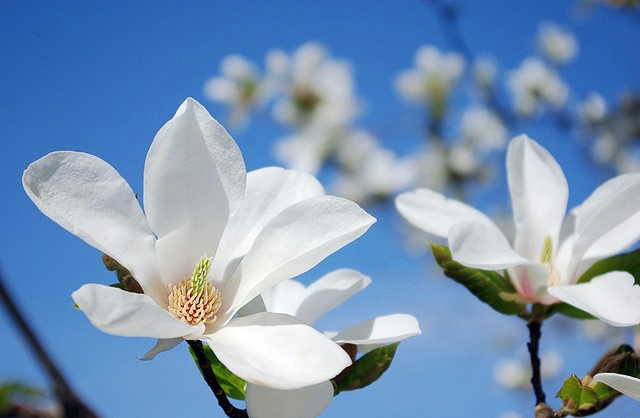

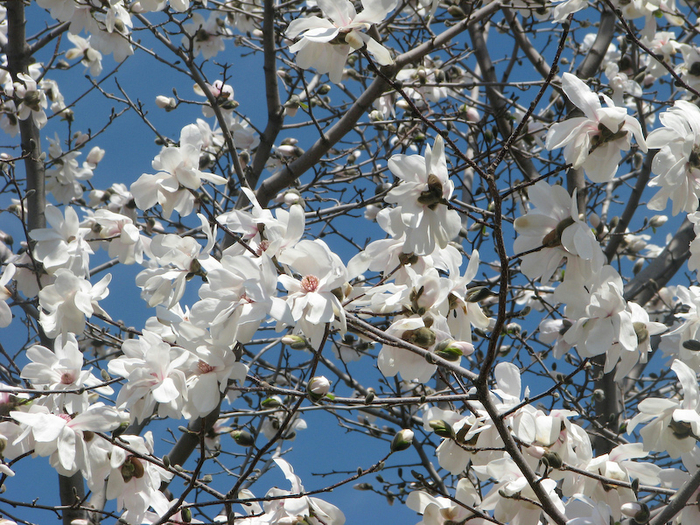

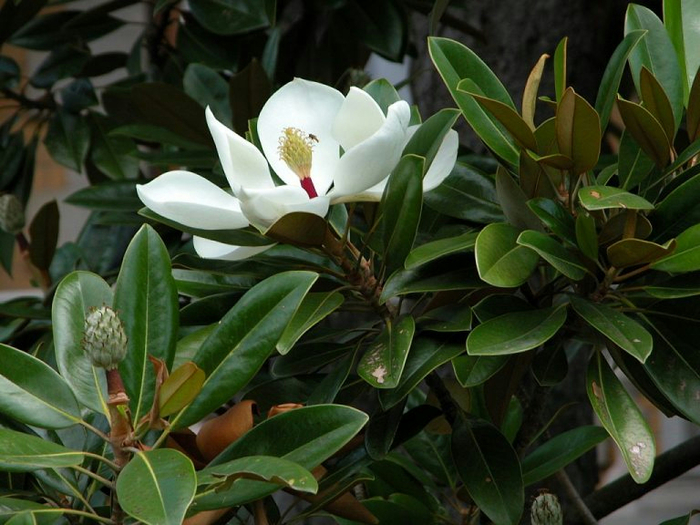

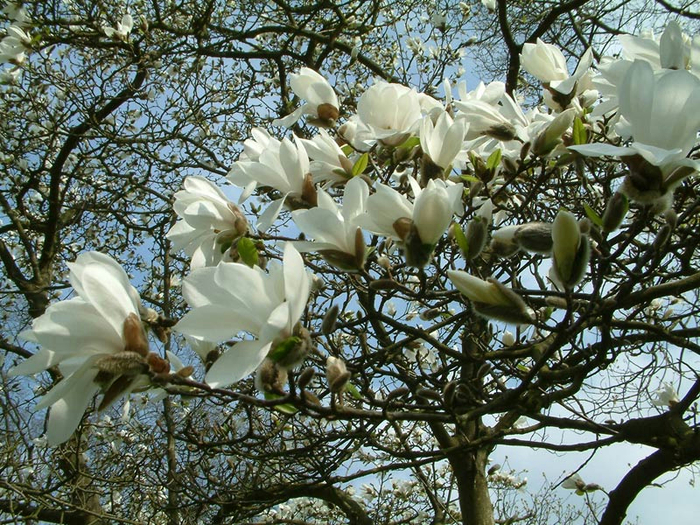
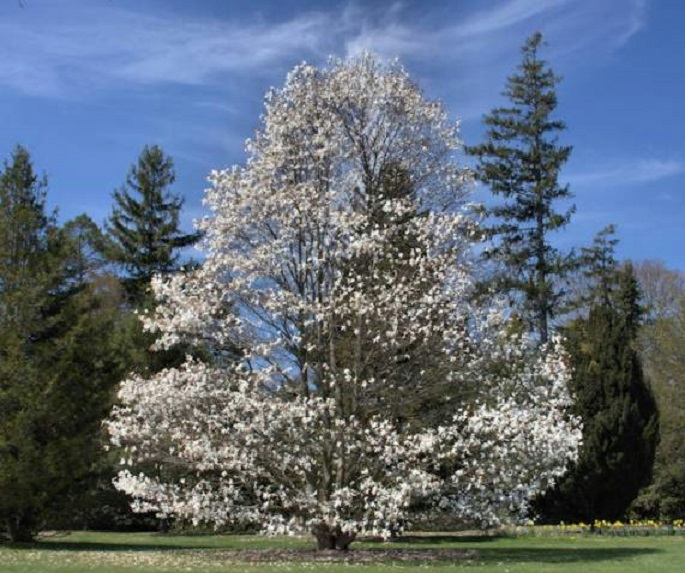
The pyramidal shape becomes irregular with the age of the tree.
You can walk around this magnolia tree in circles, its smell is very fragrant and delicate.
Yellow magnolia flowers against the blue sky. 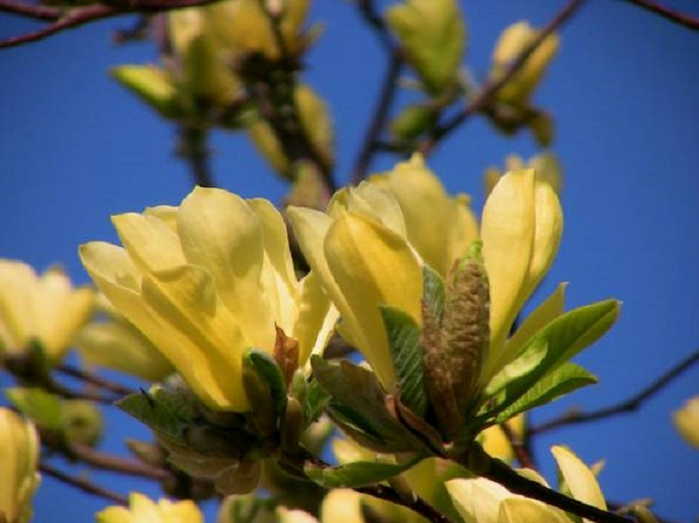
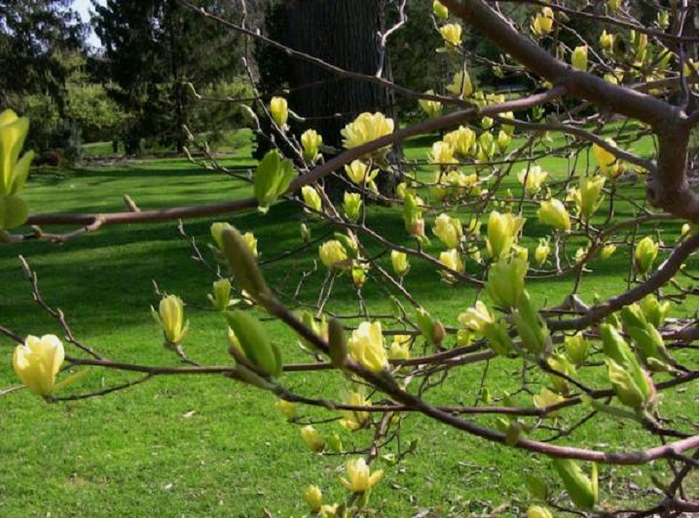

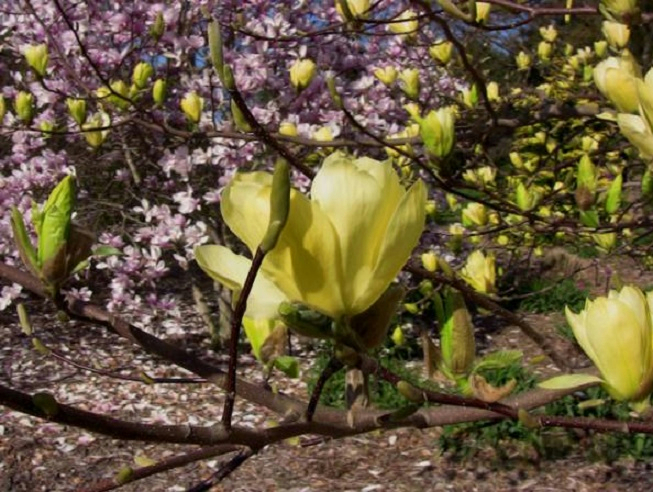

So becomes a yellow flower at the end of flowering. 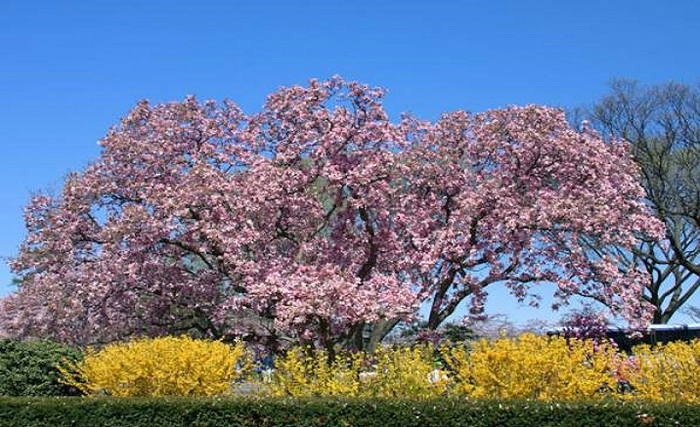
Pink magnolia 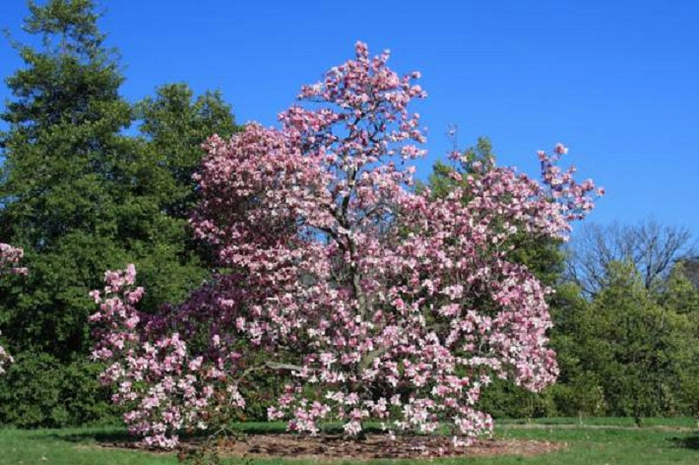
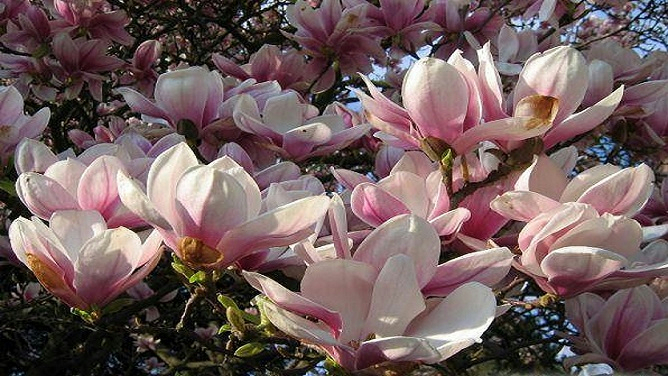
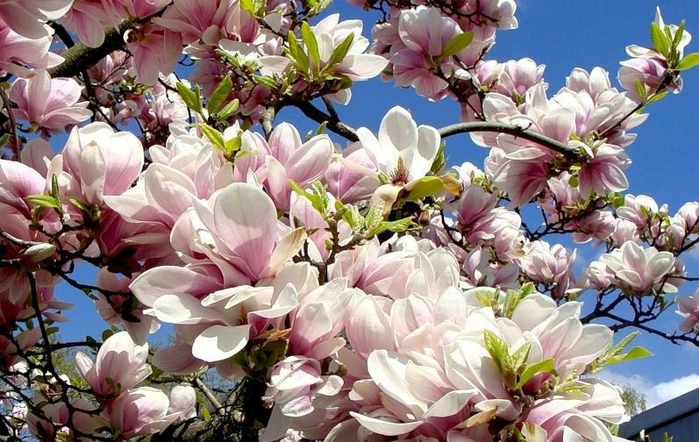
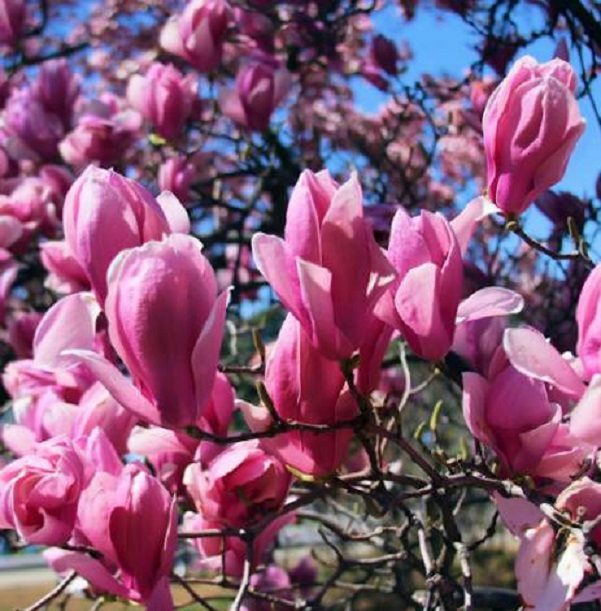
In addition to beauty, which does not leave anyone indifferent, the plant also has healing properties. Preparations containing magnolia leaves help lower blood pressure, reduce heart rate and relieve pain in the heart.
Magnolia trees were still valued by the Aztecs. Not only for healing properties. For example, canoes were made from wood. Magnolia essential oil is considered the strongest aphrodisiac, it also relieves depression, relieves muscle cramps, strengthens the nervous system and immunity.
Truly a divine flower with a marvelous aroma, perfumers simply could not ignore it. However, magnolia essential oil is a rather expensive ingredient, and therefore its presence in the perfume composition necessarily affects the price. The affordable cost of the product with the presence of magnolia means that instead of natural oil, the product uses synthetic analogs that can not be compared with the original. In addition to perfumes, the fragrant world is added to luxury cosmetics.
The smell of flowering magnolias is very pleasant, just bewitching. 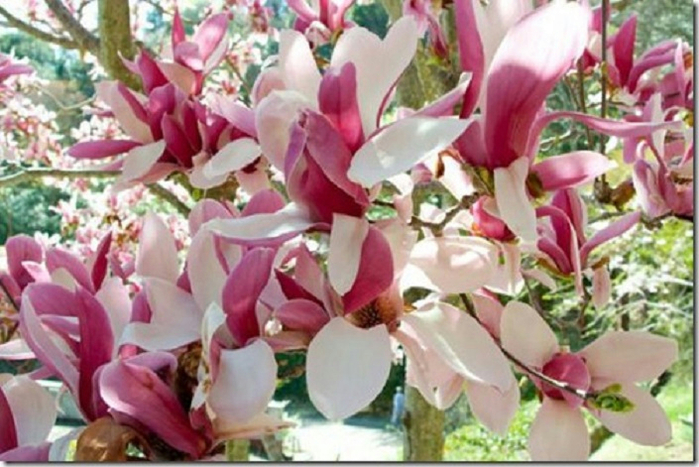
So what smells of magnolia?
Magnolias beautiful flowers
Enchant with its wondrous aroma.
Grace, the bliss of beauty
In the bends of her winged petals. ![]()
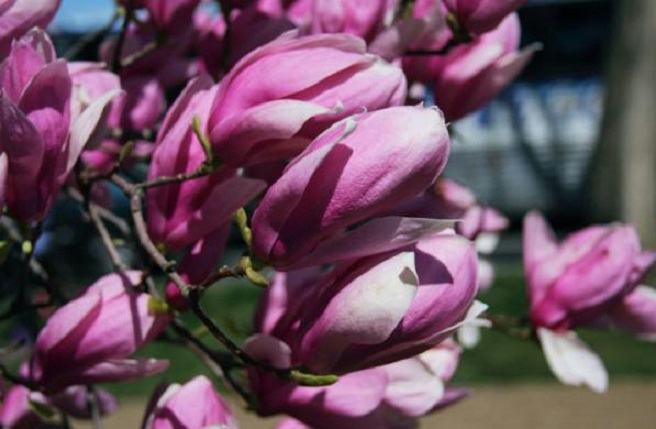
Hot southern sun, salty sea spray, sweet plum and lemon freshness, shaded by heady vanilla. The natural aroma of a flower is so complex and multifaceted that it is often used in solo parts, sometimes flavored with hot spices or shades of southern flowers.
When the magnolias bloom
The hearts of lovers will burn.
The fire of love, hope and always
Their ardor ultimately wins.
Japanese legend says:
Life entered the paper flower.
From a drop of blood of a girl alone
So Keiko idolized her choice.
And like Icarus, rising high,
Beaming your wings.
So Keiko, from love big
The last straw killed her life.
When the magnolia blooms
And the maiden color will see her
The time for marriage will come
So, as the ancient beliefs foresees.
And if the heart beats fast
In the eyes of magnolia blossom.
Relax - then God's will.
The crown will end your journey. ![]()

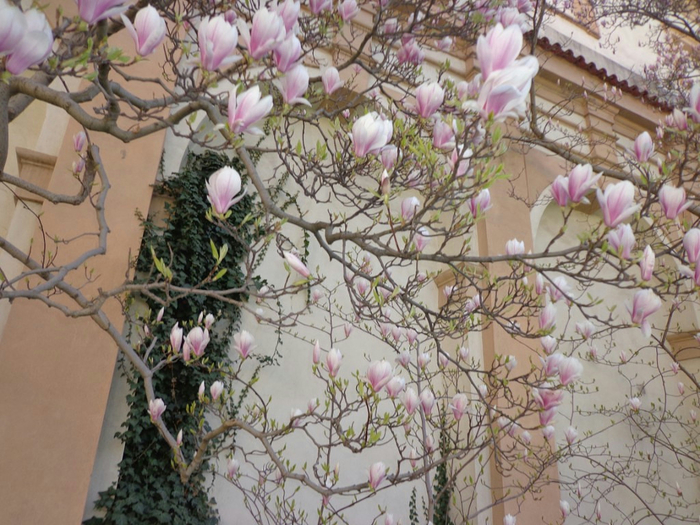
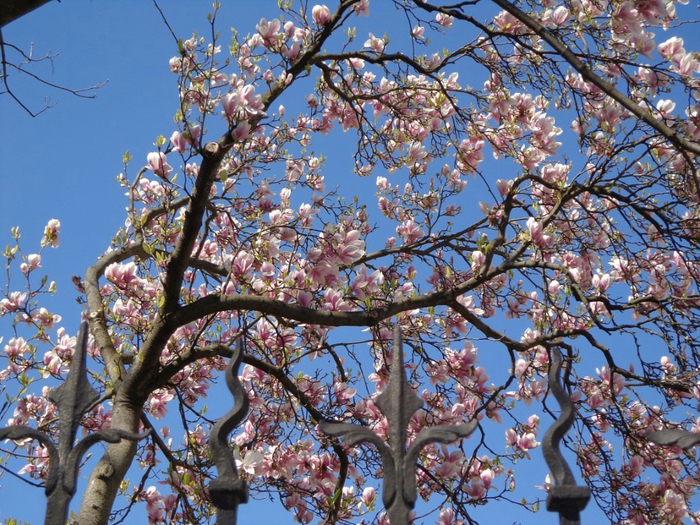
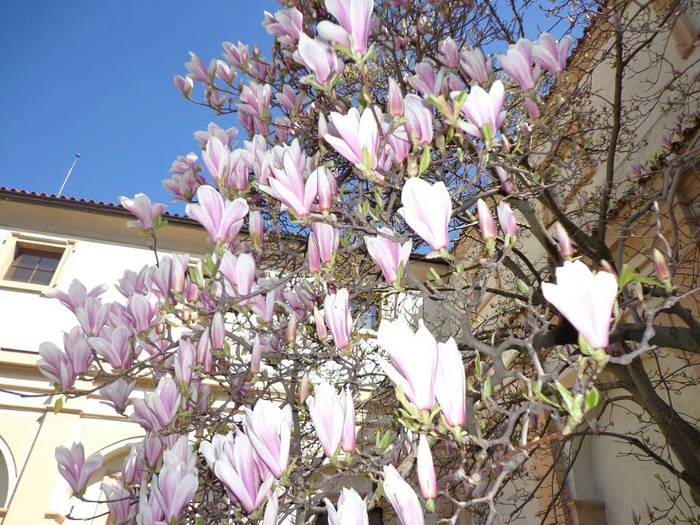




The flowering of magnolia and its majestic trees is an impressive sight. 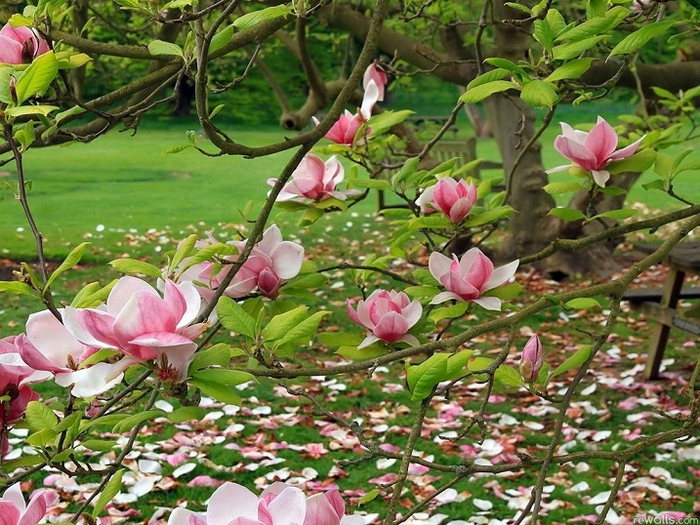
The beauty of flowering magnolia will not give way to another subtropical tree - camellia. Magnolia in bloom is distinguished by its magnificent grace. 
Magnolia! Magical property
truly hidden in you
is a solemn spring,
all eyes of the heart fixed on the soul!
Magnolia ... - all the magic of nature,
what is hidden in the tree and in the flowers,
bless like heaven vaults
opened in exquisite petals ...
The sound of the sun is wonderful
spring blossoming flowers ...
truly magical property
magnolias on the edges of the petals ... ![]()
A swirl of flowers in nature. The magnolia has faded in the garden and the carpet of the earth is covered with a pink carpet of leaves. The last flowers of pink magnolia. 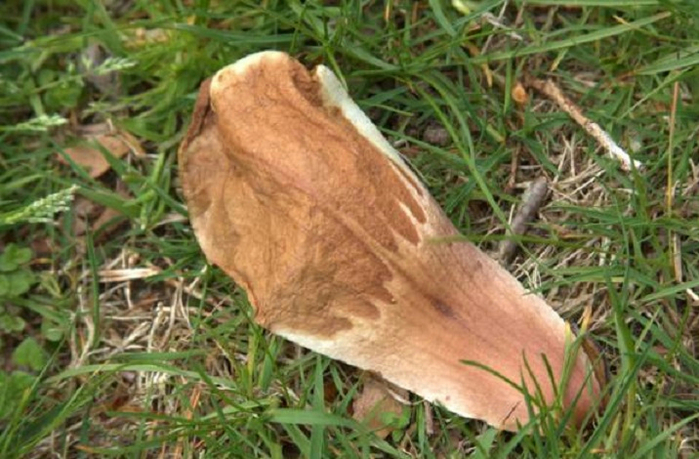
Withered Magnolia Petal 
When the flowers bloom, a surprisingly delicate carpet of magnolia petals forms on the ground. 
The beauty of magnolia flowers is unforgettable, and moments when the magnolia decorates the world with its flowers remain for a long time in memory. 
Walking in the fresh air, the positive emotions received by us, from contemplating the beauty of nature, have a beneficial effect on human health and clearly improve sleep. After all, our well-being directly depends on whether we slept or not. There are no complicated tips on how to fall asleep quickly. We just need to learn how to relax and see the beauty of nature.
The peace of mind that gives us the flowering of magnolia in the spring gives us both creative and physical strengths. 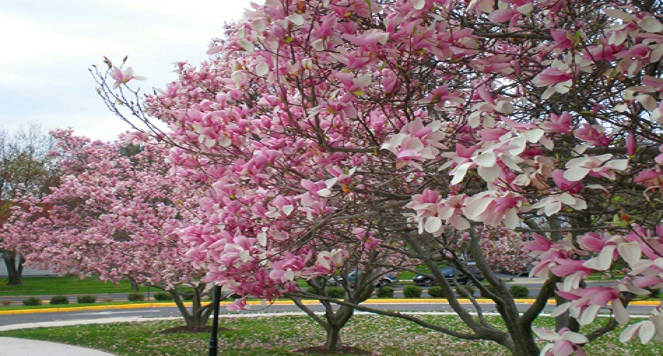

Such a variety of species and varieties - more than 60 species grows in North and Central America, Southeast and East Asia, on the islands of Java and Sumatra.
How to choose from this abundance exactly the type of magnolia that will harmoniously fit into the design of your garden?
How to grow this exotic flower in a harsh subcontinental climate?
Magnolia - this is a tree or large shrub, with evergreen or falling leaves, large flowers of white, pink, purple, and sometimes even yellow, with a pleasant aroma. The plant has a decorative appearance and is the most valuable material for landscape gardening. This is a very ancient plant, appeared on earth about 140 million years ago. The first types of magnolias grew back in the era of dinosaurs and were quite widespread. For modern gardeners, this is a rare, exotic plant with an original form of a crown and leaves, magnificent, spectacular large flowers. It blooms in April and May. Deciduous forms of magnolia bloom even before the appearance of leaves. The spectacle is magnificent!
For most people, the word “magnolia” is associated with exotics, south and warmth. Indeed, on the Black Sea coast, magnolia is widespread and is the most noticeable deciduous tree, which forms the basis of exotic landscape gardening.
In addition to southern localization, some types of magnolias successfully grow in more northern latitudes. Those gardeners who succumbed to irresistible temptation and planted this wonderful plant in their garden, are faced with the problem of the complete absence of any specific information on growing magnolias in open ground in the middle zone of Russia and Ukraine.
As a rule, magnolias are found in single copies, in collections of botanical gardens. In summer cottages and courtyards - she is quite a rare guest.
Recently, in many nurseries, Magnolia seedlings have appeared on sale. These are mainly varieties of stellate and lilac-colored magnolia, the main feature of which is a large bushy form of growth. Unfortunately, they are not highly resistant to the climatic factors of the autumn-winter period, especially to low temperatures. However, for many gardeners, both amateurs and professionals, these magnolias have been growing and blooming for many years.
- Place for planting: First of all, it is very important to choose the right place for planting the plant. Of great importance is the microclimate of the proposed landing site. Preference should be given to the south or south-west side of the garden, as the northern part and the north-eastern side are not suitable for planting. Magnolia should be planted in a sunny place and covered from the north and east winds. Shading the plant is undesirable, although on the south side it is quite acceptable.
- Watering: magnolia is very demanding on watering. Therefore, it is necessary to ensure regular watering throughout the growing season.
- Pruning: Special pruning is not required for the plant. It is enough to remove dry, curves and spoil the appearance of the branches.
- Wintering: for the winter only young plants shelter, as large specimens cannot be covered because of the large size.
Simply put, there are no special problems (except watering) with magnolias at the age of 3-4 years. After planting, the gardener has to be patient and wait for the first flowers to appear. Magnolias are plants for patient, hardworking and purposeful people.
The breeding species of magnolia grown by seed blooms for 10-14 years, hybrid species bloom faster, about 4-7 years of life. The growing process is long, but the end result is worth it!
Magnolia is propagated by seeds, cuttings and by grafting. Of these methods, seed propagation is of greatest interest. I collect the seeds of magnolia in September, they can not be overdried, because of this they quickly lose their germination. Stable types of magnolia, such as Cobus, Siebold, are recommended to be sown in the fall in the open ground, light shelter with leaves or agrofibre is possible. Seedlings grown in this way in the open field will have a higher frost resistance. When choosing seeds for planting, preference should be given to seeds collected from plants grown in an area that is similar in climatic characteristics to yours. Since the seeds from the southern magnolias will not sprout in the northern regions, and if they do, the seedlings will not winter the next winter. The resistance of plants to cold appears as a result of prolonged breeding of crops in a certain area.
Surely many people at least once had to stop in the spring in front of someone’s yard or garden, involuntarily admiring the unusual picture - luxurious pink, white or purple flowers on a beautiful and delicate tree without leaves. It is a magnolia blossom. At first glance, it might seem that such a miracle can only be brought up by experienced gardeners by investing considerable resources and putting a lot of effort. Let's try to figure out if this is so by talking about how to grow magnolia.
Magnolia - deciduous or evergreen ornamental tree and shrub from 2 to 30 m high with beautiful large flowers with a diameter of up to 25 cm, which are located one at the ends of the branches.
This is a very ancient plant. It is believed that it is the progenitor of modern flowering plants. This tree is popular in China, where there are many beliefs about it.
Did you know? Magnolia is valued not only for its beauty. Its leaves, flowers and fruits contain essential oils that help with high blood pressure, rheumatism and digestive problems. They are also used in perfumes.
 The tree came to Europe in the 17th century and it was here that it got its name - Magnolia - in honor of the director of one of the botanical gardens in France, Pierre Magnola. Since then, breeders have developed a huge assortment of species and varieties of magnolia. Today, about 80 species are cultivated, different in shape and size of the crown, color and shape of flowers.
The tree came to Europe in the 17th century and it was here that it got its name - Magnolia - in honor of the director of one of the botanical gardens in France, Pierre Magnola. Since then, breeders have developed a huge assortment of species and varieties of magnolia. Today, about 80 species are cultivated, different in shape and size of the crown, color and shape of flowers.
Magnolia: Choosing a Place to Plant
Before you take care of growing magnolia in your garden and taking care of it, you need to choose the right kind, variety and place for planting. Since the main problem of the magnolia tree is the poor tolerance of frost, when choosing a plant type, you need to pay attention to how cold winters are in your region, and what kind is suitable for your climatic conditions. The most frost-resistant - magnolia Kobus and Lebner.The harsh winters of the magnolias of Sulange, Wilson, and Ash are relatively well tolerated.
When choosing a place for planting, it must be borne in mind that this plant does not tolerate drafts, so the site should, if possible, be covered from the wind from the north and east, for example, by tall trees.
Important! Do not plant magnolia under fruit trees, as falling fruits can damage the flowers and break the branches of the plant.
 It is necessary to take care of sufficient illumination of the place so that the tree is not located in deep shadow. Also, direct sunlight should not penetrate the plant. Exceptions can be for Lebner, Kobus and star magnolias, which can grow in open areas. Cobus, in addition, is resistant to exhaust gases and industrial emissions, which allows it to land near busy motorways and in industrial areas.
It is necessary to take care of sufficient illumination of the place so that the tree is not located in deep shadow. Also, direct sunlight should not penetrate the plant. Exceptions can be for Lebner, Kobus and star magnolias, which can grow in open areas. Cobus, in addition, is resistant to exhaust gases and industrial emissions, which allows it to land near busy motorways and in industrial areas.
Today, magnolia is often used in landscape gardening, so many recommendations have been written on how to grow a color-hand tree, the main of which we share with you.
When to plant magnolia in the garden
The tree can be planted both in spring and autumn.Although experienced magnolia owners still recommend the latter option. This is due to the fact that before the autumn planting, the plant is at rest, and it is easier for it to endure the winter. And during spring planting, the tree begins to grow actively, gives a large increase and often meets winter already with shoots, which by this time have not yet had time to become covered with wood and die off.
How to plant magnolia
Magnolia is not very whimsical, however, when planting and leaving it is necessary to observe some simple rules, which, first of all, relate to soil composition, watering and top dressing.
Soil composition
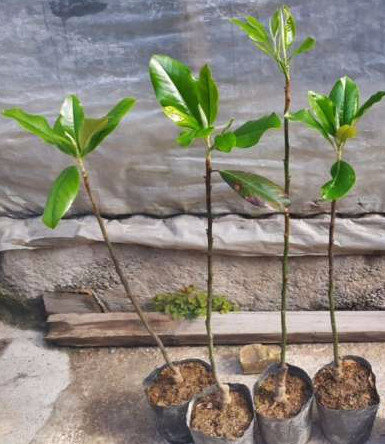 Magnolia seedling is best purchased in well-established specialized stores. Usually there they are sold in containers. Such plants tolerate both spring and autumn planting well, as they land with a lump of land to which they have already adapted. Gardeners with experience for planting recommend buying plants 1 m high with a pair of already blossoming flowers.So you will definitely know that your local climate is suitable for this type of magnolia.
Magnolia seedling is best purchased in well-established specialized stores. Usually there they are sold in containers. Such plants tolerate both spring and autumn planting well, as they land with a lump of land to which they have already adapted. Gardeners with experience for planting recommend buying plants 1 m high with a pair of already blossoming flowers.So you will definitely know that your local climate is suitable for this type of magnolia.
The soil for planting should be light, well-drained and moderately moist. Neutral or slightly acidic soil rich in organic matter is perfect.
Important! Magnolia is contraindicated in calcareous and saline land.
If the soil on your site is limy, then peat can be added to it, which will increase acidity.
Optimal soil composition:
- deciduous or sod land - 1;
- peat - 2;
- sand - 0.5.
Magnolia Planting Pattern
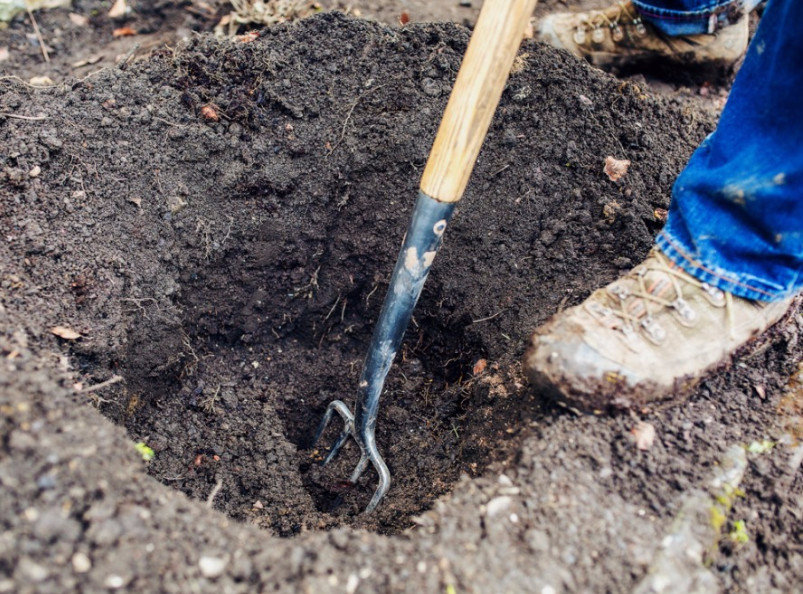 A pit for planting should be prepared in advance 3-5 times larger than the root system of the tree. Drainage is poured to the bottom of the pit - 15 cm high. Then a layer of sand (10 cm), a layer of manure (15 cm), again a layer of sand (15 cm) and a prepared soil mixture are laid. After this, the seedling is installed in a pit and covered with earth, while making sure that the root neck is not buried. The maximum recommended deepening is 2.5 cm. The earth needs to be slightly tamped and watered abundantly. The trunk section can be covered with coniferous bark, which will keep the desired level of moisture.
A pit for planting should be prepared in advance 3-5 times larger than the root system of the tree. Drainage is poured to the bottom of the pit - 15 cm high. Then a layer of sand (10 cm), a layer of manure (15 cm), again a layer of sand (15 cm) and a prepared soil mixture are laid. After this, the seedling is installed in a pit and covered with earth, while making sure that the root neck is not buried. The maximum recommended deepening is 2.5 cm. The earth needs to be slightly tamped and watered abundantly. The trunk section can be covered with coniferous bark, which will keep the desired level of moisture.
Magnolia does not tolerate transplants, so it must immediately be planted in a permanent place. If you plan to plant several trees, then the distance between them should be at least 4-5 m.
Features of magnolia care
After the magnolia planted correctly, her well-being will depend on her care. There are no fundamental differences from caring for ordinary fruit trees in this case.
Watering a plant
Watering is necessary only for young plants, and in the dry period and adults. For the well-being of the tree, it needs to be watered once a week in the amount of 2-3 buckets of water. If the summer is too dry or magnolia grows in sandy soil, then the regularity and abundance of watering can be increased.
Soil care
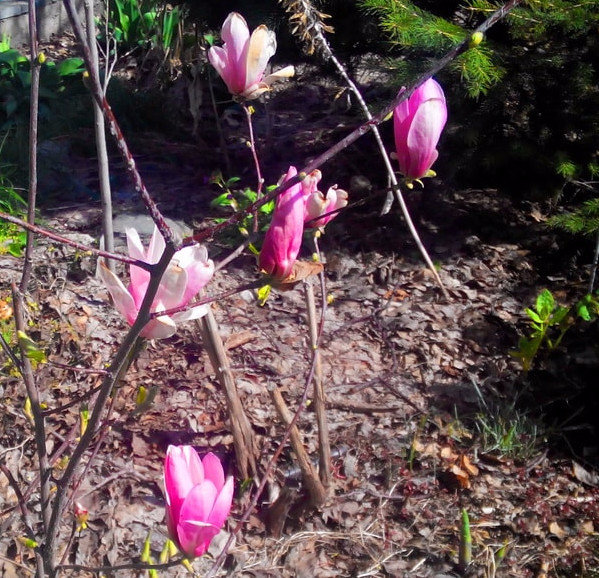 The roots of magnolias are superficial, so the ground in the basal region needs to be loosened to a depth of 20 cm, and this should be done with caution, preferably without using a shovel or rake. Weeds are best pulled out by hand. After the tree reaches 3 years, the trunk circle can be mulched with organic materials (coniferous bark, peat, sawdust, manure). This will warm the soil and serve as an additional source of nutrients. After this procedure, the earth can no longer be loosened.
The roots of magnolias are superficial, so the ground in the basal region needs to be loosened to a depth of 20 cm, and this should be done with caution, preferably without using a shovel or rake. Weeds are best pulled out by hand. After the tree reaches 3 years, the trunk circle can be mulched with organic materials (coniferous bark, peat, sawdust, manure). This will warm the soil and serve as an additional source of nutrients. After this procedure, the earth can no longer be loosened.
When and how to fertilize magnolia
You need to feed and fertilize the tree no earlier than 2 years after planting it. In early spring, you can feed your beauty with a mixture of 1 kg of mullein, 15 g of urea, 25 g of ammonium nitrate. At the beginning of autumn, nitroammophos feeding (20 g / 10 l of water) is useful. Irrigation rate - 40 liters per tree.
You can apply the fertilizer "Kemira-Universal" (1 tbsp. / 10 l of water), as well as special fertilizers "For magnolia."
Important! If at the end of July the leaves on the magnolia began to dry, this means that an overdose of fertilizers occurred. In this case, the plant is prescribed weekly abundant watering.
Plant pruning
Since magnolias do not tolerate pruning, this procedure is necessary only for decorative purposes in the first years after planting to give the desired shape to the crown. It is contraindicated to get involved in this process, as this can provoke less active flowering. In the future, only sanitary pruning is recommended once a year, in which dry, curved, damaged branches are removed. If the crown is thickened, then it is thinned out. In order for the sections to heal quickly, they must be covered with garden var.
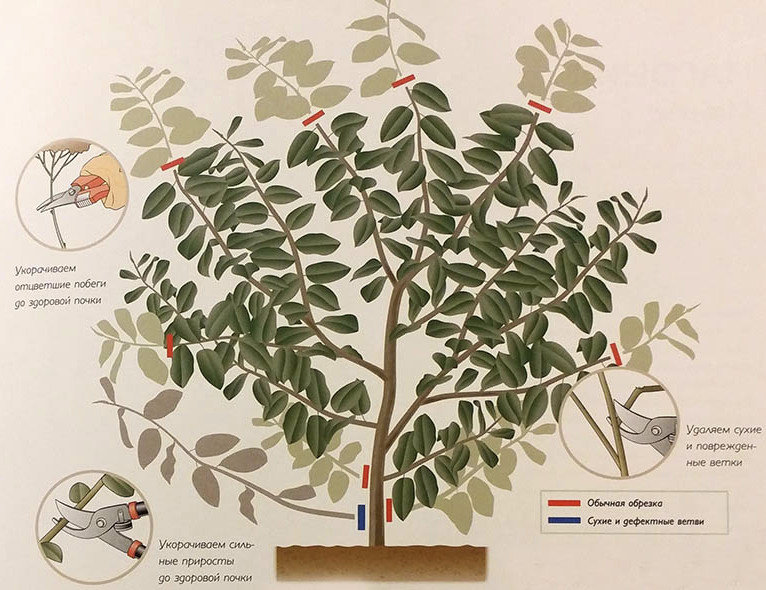
Magnolia: how to save a plant in winter
In winter, adult trees tolerate temperatures up to -25-30 ° С. Therefore, the question of how to preserve ripe magnolia in winter is no longer before its owner. But young plants need to worry. In the first 3 years, their lower part of the trunk and the root system (or even the whole tree) must be insulated with a special agrofabric (lutrasil), burlap, straw or fir spruce branches. With age, the frost resistance of magnolias increases.
In subsequent years, the earth in the near-stem circle in the autumn should be mulched with sawdust, pine bark, peat.
Methods of propagating magnolia
Magnolias reproduce in three ways:
- seeds
- layering and cuttings,
- vaccinations.
Seeds
 In nature, magnolias are propagated by seeds carried by birds. You can also try sowing a tree from seeds. You need to do this in the fall, immediately after picking berries. Or put it off until spring, but keep the seeds in a plastic bag in the refrigerator.
In nature, magnolias are propagated by seeds carried by birds. You can also try sowing a tree from seeds. You need to do this in the fall, immediately after picking berries. Or put it off until spring, but keep the seeds in a plastic bag in the refrigerator.
Previously, the seeds must be filled with water for 3 days, and then cleaned of a dense oily shell (for example, wiping through a sieve). After cleaning, they should be washed in a mild soapy solution and rinsed in clean water several times. Sow in crates to a depth of 3 cm in universal soil. Remove the containers to the cellar until spring. In early March, they need to be moved to the windowsill before emergence. Seedlings can be planted in a year. So you will have a hand-grown magnolia, to the birth of which you will already know well how to care for it.
Did you know? Since magnolia in nature lives in areas with wet summers and dry, warm winters, seedlings grow slowly in the first year of life. Leaves can be expected only in the middle of summer, and seedlings will begin to grow actively only in the fall.
Cuttings
 In the vegetative method of propagation (layering and cuttings), magnolias enter the flowering phase earlier than seed seeds. This method gives the best result in the early years of the tree.
In the vegetative method of propagation (layering and cuttings), magnolias enter the flowering phase earlier than seed seeds. This method gives the best result in the early years of the tree.
When propagating by layering in spring, you need to bend and sprinkle one of the lower branches with earth. After a year or two, roots should form on it. After this, the layering is carefully separated from the mother tree and transplanted for growing.
At the end of July, you can try cuttings. Cuttings are taken from young trees, leaving 2-3 leaves in the upper part. The lower part is treated with any substance for root formation. Then they are planted in a greenhouse, in a container with sand, covered with a lid and maintained at a temperature of + 19-22 ° C and the necessary humidity. Rooting should occur after 5-8 weeks. Cuttings are planted in open ground in a year. If the cuttings were carried out immediately into the ground, then they need to provide good shelter so that they can tolerate the cold.
Vaccinations
The method of reproduction by vaccination allows to achieve rapid plant growth, early fruiting, increase its endurance. However, this method is more time-consuming than cuttings. Vaccinations are carried out in early spring in a greenhouse or in the open ground by methods of improved copulation, butt stock or lateral incision.
Despite its non-trivial beauty and apparent fragility, magnolia is unpretentious when grown. It grows quite quickly, very rarely gets sick and is practically not damaged by pests and rodents. If you provide her with proper care, for many years every spring she will delight you with flowering and aroma.
Was this article helpful?
Well no


